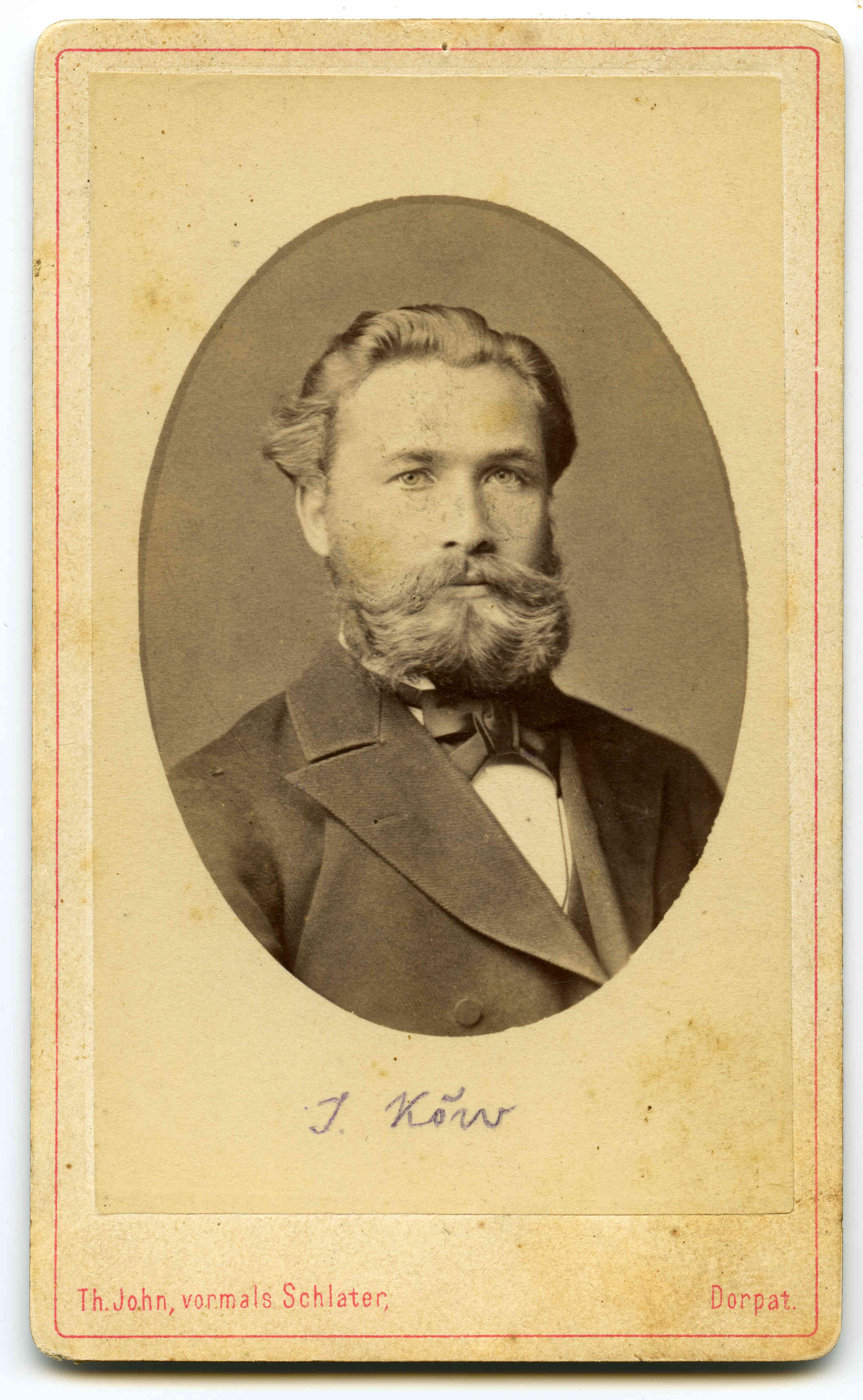
Jakob Kõrv
Jakob Kõrv (3. XII/ 21. XI 1849 – 6.IX 1916) was a journalist, prose writer and translator.
He was born in Kodavere parish, Tartu county, attended the local village school and Kodavere parish school, took the examination as a village schoolteacher, and from 1868 to 1874 was the schoolteacher at Alatskivi. In 1874 he moved to Tartu, and attended lectures at the University of Tartu. He worked in Tartu as a secretary of the Estonian Farmers’ Association until 1881, when he was invited to Viljandi by Carl Robert Jakobson to be assistant editor of the journal Sakala. In 1882 he started producing the journal Valgus, which initially took up the national-radical line of Sakala, but by the end of the eighties came to defend the policy of Russification. In his day he was known for his complaints and intrigues against other journals, which gave rise to a conflict with the wider public. He was also ejected from the Society of Estonian Men of Letters. At the beginning of the 20th century he sold Valgus and spent the last years of his life in Switzerland, where he died. His remains were interred at Rahumäe cemetery in Tallinn.
Kõrv’s literary career began with translations and adaptations, like Luigemäe Olli (‘Olli of Luigemägi’, in Valgus 1887-1888; as a book, 1893) and Kiired kosjad (‘The Urgent Wedding’, in Valgus 1887; as a book, 1893) which were published in the wake of the historical tales that were popular at the time. The stories were presented as originals, but turned out to be interpreted adaptations of works by Chateaubriand in the first case and André Theuriet in the second, which provoked lively reactions in the press. The discussion about the originality of Jakob Kõrv’s tales also marks the end of the era of the prose adaptation in Estonian literature.
Regarded as the most important of Kõrv’s works is the story Kindel eesmärk (‘A Certain Goal’, Valgus 1885-1886, in book form 1888), which depicts gardener’s son’s path to being a millionaire, by fair means or foul. The cult of money and revenge on the estate owner have a central place. The story is relatively meagre, which a cliché-ridden plot, and does not give importance to psychological depth. Relations between estate owners and peasants in the 18th century are also the subject of the novel Öö ja koit (‘Night and Dawn’, Valgus and supplement 1892-1894).
Kõrv also collected folk poetry and published folk-tales in re-edited form. The emphasis was on the tales and legends from Kõrv’s home district of Kodavere parish. Eesti-rahva muistejutud ja vanad kõned I (‘Legends and Old Tales of the Estonian People’, 1881) consists of Kalevipoeg-related legends and stories of water-sprites and nixies. One of Kõrv’s best known and most often republished tales is Veealused (‘The Water-Dwellers’). For a long time Kõrv collected folk stories about Kaval-Ants and Vanapagan and gathered them in the cycle Kaval-Ants ja Vanapagan (‘Crafty Hans and the Old Devil’, Valgus 1885-1886). Kõrv’s legends were absorbing and written in a good style.
Kõrv translated into Estonian, for example Pushkin’s ‘The Captain’s Daughter’ (Pealiku tütar, 1879), which is, despite excisions and varying quality in the translation, the first prose work by Pushkin to appear in Estonian; and Tolstoy’s ‘War and peace’ (Sõda ja rahu, Valgus 1893-1898, in book form 1894).
Kõrv also published reviews and articles on literature, for example taking issue against the new literary style of realism and its prominent representative Eduard Vilde. Kõrv also compiled a Russian-Estonian dictionary (1889).
A. K. (Translated by C. M.)
Books in Estonian
Stories
Kindel eesmärk: Eesti jutt. Tartu: Eesti Kirjameeste Selts, 1888, 263 lk.
Kiired kosjad: Eesti jutt: Luokene Tallinnast. Tallinn, 1893, 138 lk.
Luigemäe Olli: Kujutused Eesti minewikust 1217-1224. Tallinn, 1893, 100 lk.
Folk-tales and legends
Eesti-rahva muiste-jutud ja wanad-kõned. Esimene kimbukene. Viljandi, 1881, 56 lk.
Vaesemehe poeg. Tallinn: Pääsuke, 1934, 96 lk.
Muinasjutud. Tallinn: Pääsuke, 1935, 96 lk.
Mustjärve sünd: muinasjutud. Tallinn: Pääsuke, 1935, 32 lk.
Näkineiu: muinasjutud. Tallinn: Pääsuke, 1935, 32 lk.
Veealused. Tallinn: Ilukirjandus ja Kunst, 1944, 14 lk. [Järgmised trükid: 1989, 1994, 2011.]
Miscellaneous
Reisi- ja jahi-pildid wõeratest maadest: noore- ja wana rahwalle lõbusaks ja õpetliseks lugemiseks. Tartu, 1880, 99 lk.
Lühikene Aiapidamise juhatus. Tartu: Schnakenburg, 1881, 48 lk.
Tarwiline õpetus Maja-aia pidamisest. Kodule ja koolile ja kõigile aia-armastajatele. Tartu: K. Mattiesen, 1881, 192 lk.
Wene-Türgi sõda 1877. 1.-4. anne. Tartu: H. Laakmann, 1877-1878.



